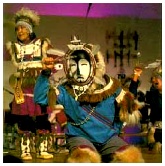
 The Cradle of Eskimo Civilization The Yup'ik occupy the north-east tip of Siberia as well as coastal areas of Alaska. Some Yup'ik families in Russian Siberia have American relatives only a short distance away on Alaska's St. Lawrence Island. The name Yup'ik means "Real People" (as it does in Inuktitut). In that language, yuk means "person or "human being" and pik is added, meaning "real" or "genuine".
Famous for their sea hunting culture, the Yup'ik maintained their traditional way of life well into the 20th century. They believed in spirits and each village had a shaman who served as a healer and contacted spirit helpers to ward off evil. It was important to respect the sea animals that were depended upon for sustenance, and special ceremonies were held before the departure of hunting boats.
Click pictures for more information and credits. Library: Arctic, Arctic Animals Whales/Fish, Arctic Birds Links: Arctic, Arctic Animals Arctic Maps & Weather Reports |

|
DICTIONARY: Just "double-click" any unlinked word on this page for the definition from Merriam-Webster's Student Electronic Dictionary at Word Central. |

|
ARCTIC LIBRARY & GLOSSARY: Check this section for an index of the rest of the things you really need to know about the Arctic. |

|
ARCTIC MAPS & WEATHER REPORTS: Maps of the Northwest Passage, explorers' routes, iceberg sources, Nunavut, the Arctic by treeline, temperature... |

|
ARCTIC LINKS: Even more information! Links to sites related to the Arctic and "Iceberg: the Story of the Throps and the Squallhoots". |

|
GUIDE TO ARCTIC SUNRISE & SUNSET: How much sunlight or darkness is there in the Arctic on each day of the year? |
to is the property of their respective owners, and Athropolis is not responsible for their content.
